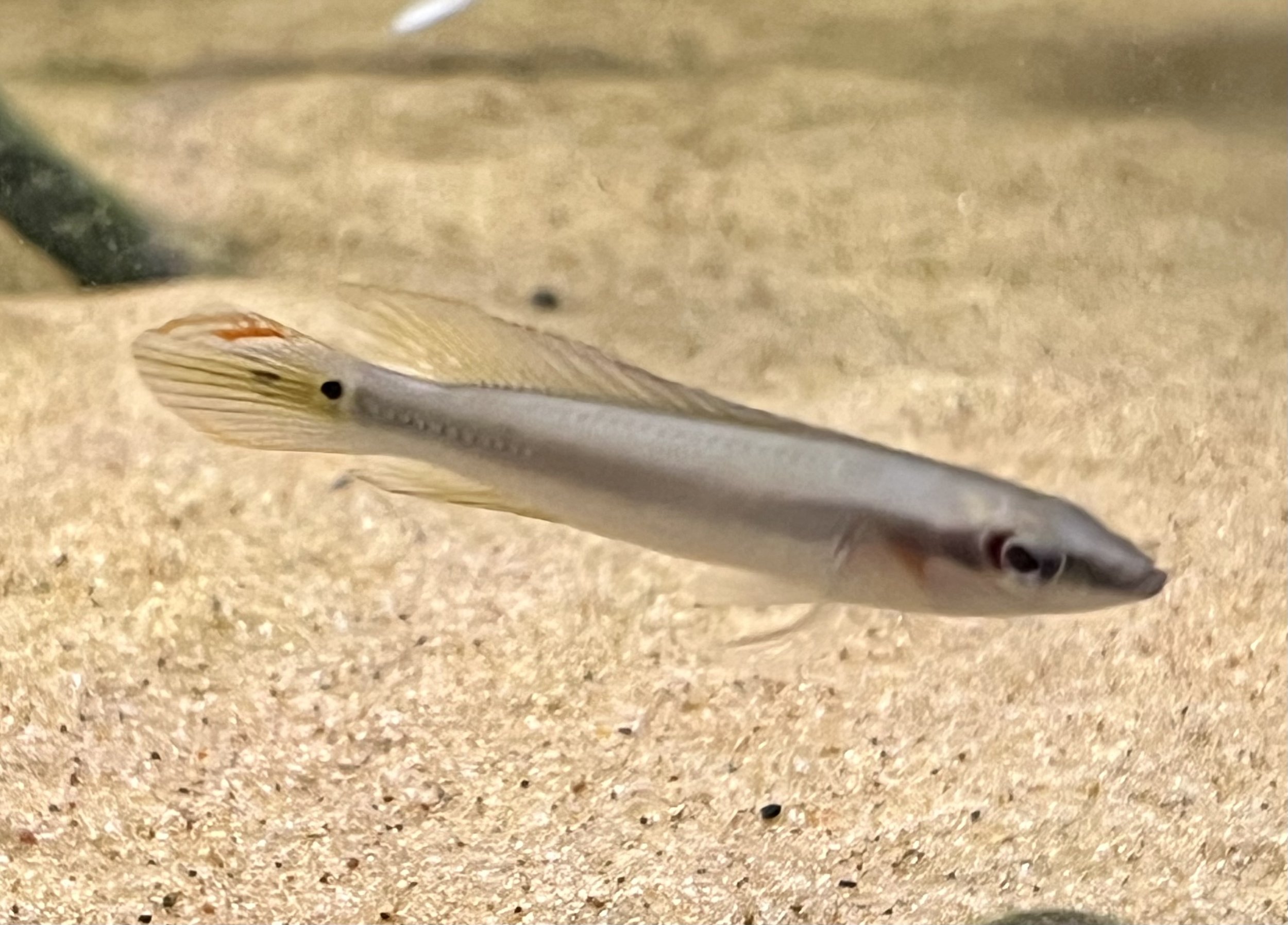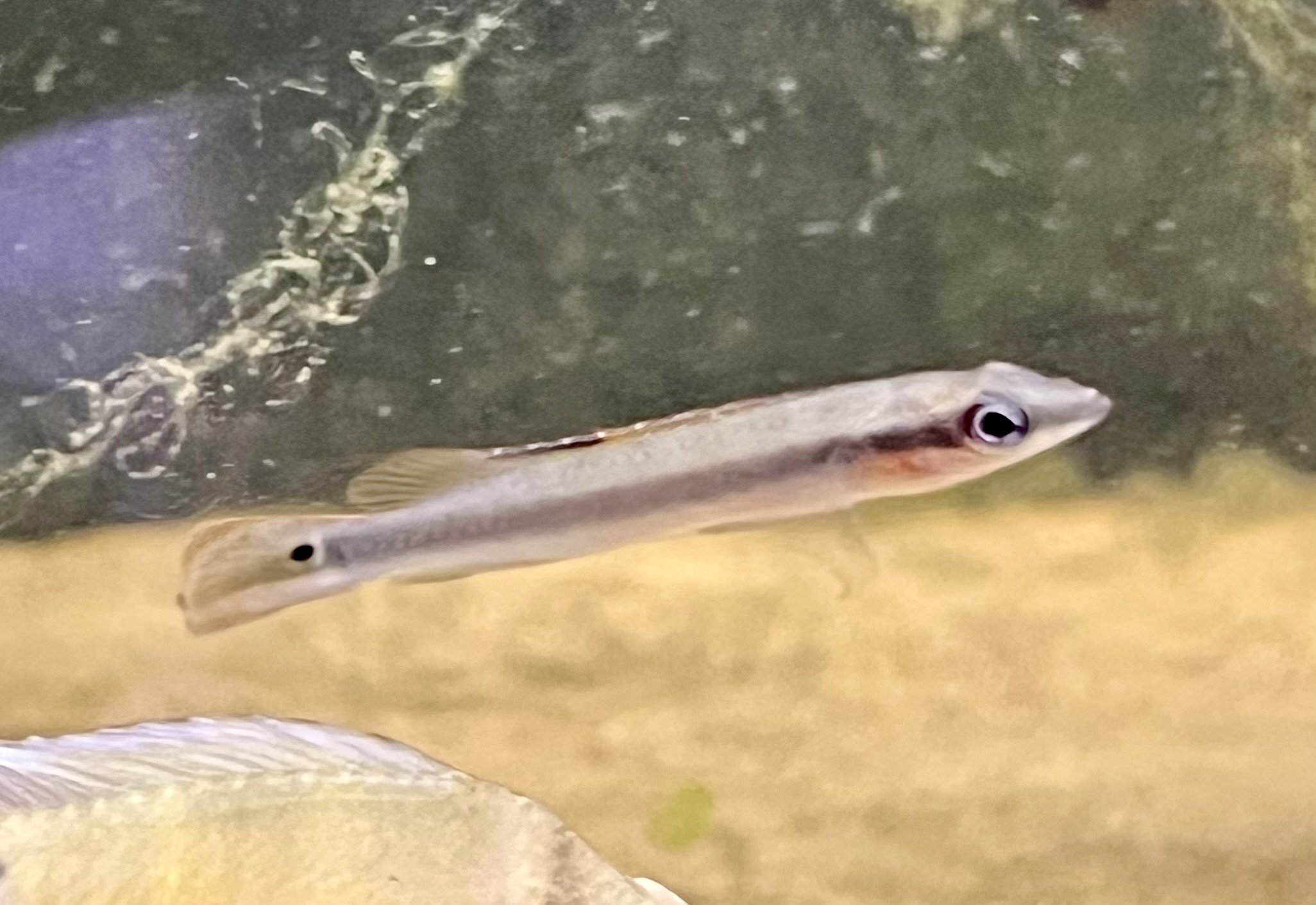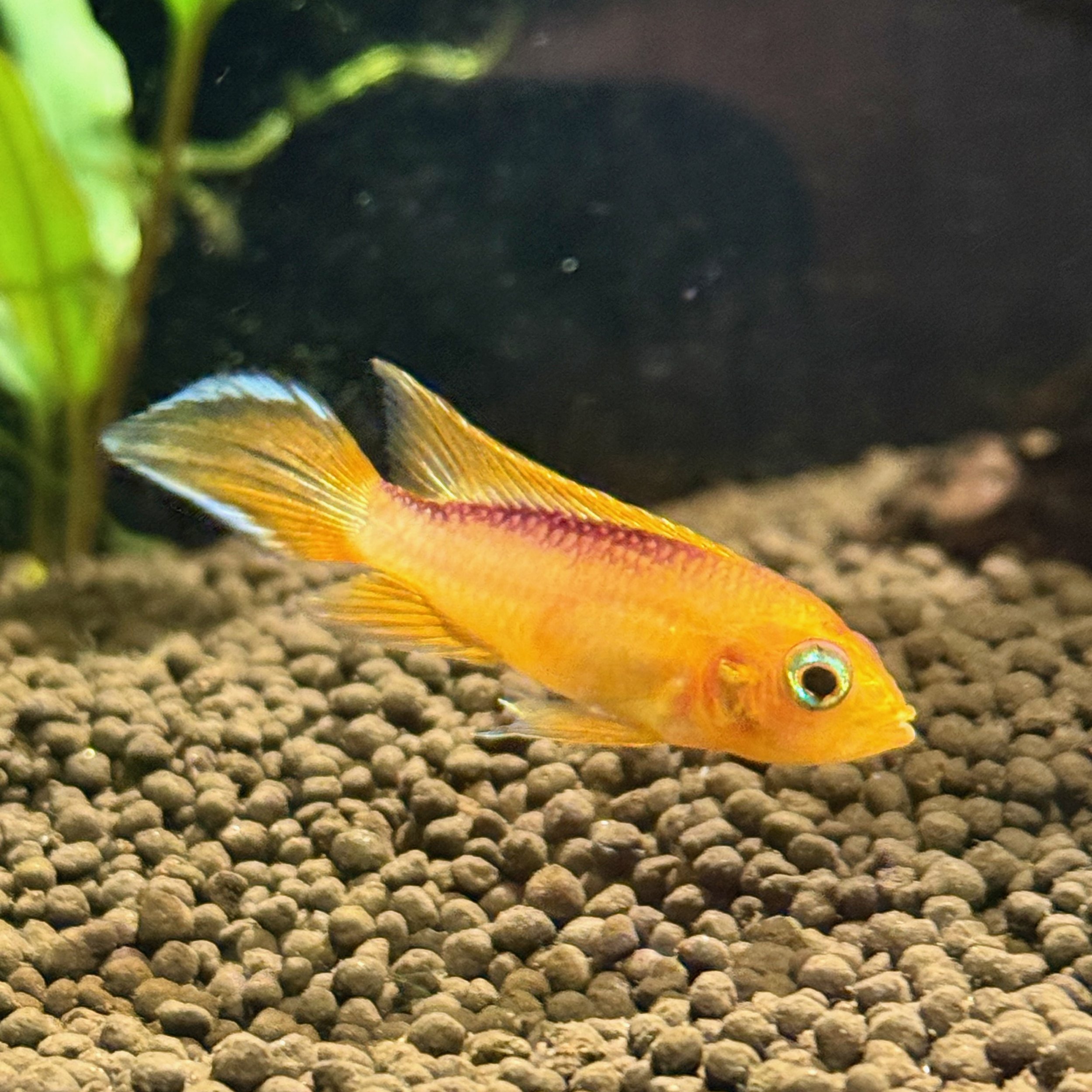 Image 1 of 2
Image 1 of 2

 Image 2 of 2
Image 2 of 2



Bolivian Ram
The Bolivian Ram, scientifically known as Mikrogeophagus altispinosus, is a captivating and peaceful freshwater cichlid species cherished by aquarists for its vibrant colors, gentle temperament, and engaging behavior. Native to the slow-moving rivers and streams of Bolivia and Brazil, these beautiful fish make excellent additions to community aquariums.
Physically, Bolivian Rams exhibit a stunning array of colors. Their bodies are adorned with shades of gold, yellow, and orange, often highlighted by blue or green iridescence. They feature a characteristic black "spot" on their midsection and dark vertical bars that can become more pronounced depending on their mood. Their elongated fins are often fringed with red or blue, adding to their visual appeal. Mature specimens typically reach lengths of around 3 to 3.5 inches (7.5 to 9 centimeters).
In aquariums, Bolivian Rams thrive in well-planted tanks with plenty of hiding spots provided by rocks, driftwood, and dense vegetation. These fish are known for their peaceful nature and are suitable for community tanks with other non-aggressive species. They appreciate a substrate of fine sand or smooth gravel, which allows them to exhibit their natural digging behavior.
Water parameters for Bolivian Rams should closely resemble those of their native habitat to ensure their health and well-being. They prefer warm water temperatures ranging from 74 to 78°F (23 to 26°C) and slightly acidic to neutral pH levels between 6.0 to 7.5. Maintaining good water quality with regular water changes and efficient filtration is essential for their overall health.
Feeding Bolivian Rams is relatively straightforward, as they are omnivorous and will accept a variety of foods. A balanced diet consisting of high-quality flakes, pellets, and granules should be supplemented with live or frozen foods such as bloodworms, brine shrimp, and daphnia to ensure optimal health and vibrant coloration. Providing a varied diet helps to meet their nutritional needs and keeps them active and healthy.
Breeding Bolivian Rams in captivity can be a rewarding experience for aquarists. They form monogamous pairs and exhibit excellent parental care. To encourage breeding, provide a separate breeding tank with soft, slightly acidic water and flat surfaces such as stones or broad leaves for egg-laying. Once eggs are laid and fertilized, both parents will guard the eggs and tend to the fry until they become free-swimming. The fry can be fed on infusoria or finely powdered fry food until they are large enough to accept larger foods.
Overall, the Bolivian Ram is a delightful and visually striking addition to freshwater aquariums, prized for its beauty, peaceful demeanor, and fascinating behavior. With proper care and attention to their specific requirements, these enchanting cichlids can thrive and bring joy to aquarists of all levels of experience, enhancing the beauty and vibrancy of any aquatic environment.
The Bolivian Ram, scientifically known as Mikrogeophagus altispinosus, is a captivating and peaceful freshwater cichlid species cherished by aquarists for its vibrant colors, gentle temperament, and engaging behavior. Native to the slow-moving rivers and streams of Bolivia and Brazil, these beautiful fish make excellent additions to community aquariums.
Physically, Bolivian Rams exhibit a stunning array of colors. Their bodies are adorned with shades of gold, yellow, and orange, often highlighted by blue or green iridescence. They feature a characteristic black "spot" on their midsection and dark vertical bars that can become more pronounced depending on their mood. Their elongated fins are often fringed with red or blue, adding to their visual appeal. Mature specimens typically reach lengths of around 3 to 3.5 inches (7.5 to 9 centimeters).
In aquariums, Bolivian Rams thrive in well-planted tanks with plenty of hiding spots provided by rocks, driftwood, and dense vegetation. These fish are known for their peaceful nature and are suitable for community tanks with other non-aggressive species. They appreciate a substrate of fine sand or smooth gravel, which allows them to exhibit their natural digging behavior.
Water parameters for Bolivian Rams should closely resemble those of their native habitat to ensure their health and well-being. They prefer warm water temperatures ranging from 74 to 78°F (23 to 26°C) and slightly acidic to neutral pH levels between 6.0 to 7.5. Maintaining good water quality with regular water changes and efficient filtration is essential for their overall health.
Feeding Bolivian Rams is relatively straightforward, as they are omnivorous and will accept a variety of foods. A balanced diet consisting of high-quality flakes, pellets, and granules should be supplemented with live or frozen foods such as bloodworms, brine shrimp, and daphnia to ensure optimal health and vibrant coloration. Providing a varied diet helps to meet their nutritional needs and keeps them active and healthy.
Breeding Bolivian Rams in captivity can be a rewarding experience for aquarists. They form monogamous pairs and exhibit excellent parental care. To encourage breeding, provide a separate breeding tank with soft, slightly acidic water and flat surfaces such as stones or broad leaves for egg-laying. Once eggs are laid and fertilized, both parents will guard the eggs and tend to the fry until they become free-swimming. The fry can be fed on infusoria or finely powdered fry food until they are large enough to accept larger foods.
Overall, the Bolivian Ram is a delightful and visually striking addition to freshwater aquariums, prized for its beauty, peaceful demeanor, and fascinating behavior. With proper care and attention to their specific requirements, these enchanting cichlids can thrive and bring joy to aquarists of all levels of experience, enhancing the beauty and vibrancy of any aquatic environment.
The Bolivian Ram, scientifically known as Mikrogeophagus altispinosus, is a captivating and peaceful freshwater cichlid species cherished by aquarists for its vibrant colors, gentle temperament, and engaging behavior. Native to the slow-moving rivers and streams of Bolivia and Brazil, these beautiful fish make excellent additions to community aquariums.
Physically, Bolivian Rams exhibit a stunning array of colors. Their bodies are adorned with shades of gold, yellow, and orange, often highlighted by blue or green iridescence. They feature a characteristic black "spot" on their midsection and dark vertical bars that can become more pronounced depending on their mood. Their elongated fins are often fringed with red or blue, adding to their visual appeal. Mature specimens typically reach lengths of around 3 to 3.5 inches (7.5 to 9 centimeters).
In aquariums, Bolivian Rams thrive in well-planted tanks with plenty of hiding spots provided by rocks, driftwood, and dense vegetation. These fish are known for their peaceful nature and are suitable for community tanks with other non-aggressive species. They appreciate a substrate of fine sand or smooth gravel, which allows them to exhibit their natural digging behavior.
Water parameters for Bolivian Rams should closely resemble those of their native habitat to ensure their health and well-being. They prefer warm water temperatures ranging from 74 to 78°F (23 to 26°C) and slightly acidic to neutral pH levels between 6.0 to 7.5. Maintaining good water quality with regular water changes and efficient filtration is essential for their overall health.
Feeding Bolivian Rams is relatively straightforward, as they are omnivorous and will accept a variety of foods. A balanced diet consisting of high-quality flakes, pellets, and granules should be supplemented with live or frozen foods such as bloodworms, brine shrimp, and daphnia to ensure optimal health and vibrant coloration. Providing a varied diet helps to meet their nutritional needs and keeps them active and healthy.
Breeding Bolivian Rams in captivity can be a rewarding experience for aquarists. They form monogamous pairs and exhibit excellent parental care. To encourage breeding, provide a separate breeding tank with soft, slightly acidic water and flat surfaces such as stones or broad leaves for egg-laying. Once eggs are laid and fertilized, both parents will guard the eggs and tend to the fry until they become free-swimming. The fry can be fed on infusoria or finely powdered fry food until they are large enough to accept larger foods.
Overall, the Bolivian Ram is a delightful and visually striking addition to freshwater aquariums, prized for its beauty, peaceful demeanor, and fascinating behavior. With proper care and attention to their specific requirements, these enchanting cichlids can thrive and bring joy to aquarists of all levels of experience, enhancing the beauty and vibrancy of any aquatic environment.








